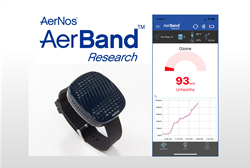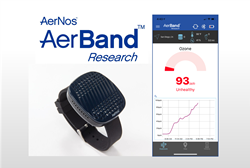[ad_1]

Ozone Gas Detector by AerNos
AerBand Research is a breakthrough that will lead to better answers to the most urgent questions – what pollutants are we exposed too, what matters and how do we avoid them.
SAN DIEGO (PRWEB)
October 06, 2020
AerNos, an innovator in nano gas sensors, is now shipping a game-changing wearable device for air pollution detection and research first showcased during CES 2018 on Good Morning America’s CES coverage. Called AerBand Research, the wearable or clip-able device will revolutionize how scientific studies track and study human exposure to harmful air pollutants.
Scientists, physicians and researchers have long been aware of the connection between air pollution and human health but have been stifled by current air quality monitoring capabilities. AerNos has leveraged advances in nanotechnology, engineering and data science to develop a low-cost nano gas sensor able to detect multiple gases simultaneously to parts-per-billion levels. This will enable scientists, for the first time, to monitor 24/7 individual exposures to toxic gases in research and enable consumers to take steps to reduce or avoid exposures and the health impacts that come with exposure.
According to the Environmental Protection Agency (EPA), ground level Ozone in the air we breathe can harm our health. People most at risk from breathing air containing ozone include people with asthma, children, older adults, and people who are active outdoors, especially outdoor workers. In addition, people with certain genetic characteristics, and people with reduced intake of certain nutrients, such as vitamins C and E, are at greater risk from ozone exposure.
Breathing Ozone can trigger a variety of health problems including chest pain, coughing, throat irritation, and airway inflammation. It also can reduce lung function and harm lung tissue. Ozone can worsen bronchitis, emphysema, and asthma, leading to increased medical care. Ozone exposure has been associated with increase emergency room visits, years of life lost and premature deaths.
“AerBand Research is a breakthrough that will lead to better answers to the most urgent questions I’m hearing from parents everyday – what pollutants are we exposed too, what matters and how do we avoid them,” said Christopher Gavigan, Founder and CEO of Prima, Co-Founder of The Honest Company and AerNos Advisor. “Air pollution monitoring today does not tell me what I’m breathing right here, right now. It significantly limits health research and our ability to take action. AerBand is about to change that.”
AerBand Research is designed to be worn or attached via clip for always-on air pollution monitoring. AerNos’ nano gas sensor technology enables simultaneous detection of multiple indoor and outdoor airborne toxins to ppb levels. AerBand pairs with an end user App for tracking real-time pollution levels, historical information and for accessing recommended actions. Organizations access data via the AerBand Data Cloud website – including detailed air pollution readings from multiple research participants.
“For the first time ever, the world of researchers will be able to monitor 24/7 personal exposure to Ozone and correlate its impact on health and wellness,” said Sundip R. Doshi, Chairman & CEO of AerNos, Inc. “Utilizing AerNos’ AerN2S Technology, our ability to design, developed and manufacture millions of tiny gas sensing elements will enable AerNos and its product partners to bring to the market meaningful gas monitoring solutions.”
In addition Ground Level Ozone’s impact on human health, Ozone affects sensitive vegetation and ecosystems, including forests, parks, wildlife refuges and wilderness areas. Ozone can especially cause damage during the growing season. According to the EPA and other experts, the effects of ozone can then have negative impacts on ecosystems, including loss of species diversity (less variety of plants, animals, insects, and fish), changes to the specific assortment of plants present in a forest, changes to habitat quality, changes to water and nutrient cycles. Furthermore, reducing ground-level ozone can have the following positive impacts on vegetation including protecting forest communities and Improving yields for timber and some crops, such as soybeans and winter wheat.
About AerBand Research, Pricing & Availability
AerBand™ Research is a portable product designed to detect airborne toxins to the parts-per-billion for universities, institutions and organizations conducting research related to the impact of air pollution on health and wellness. AerBand Research for ground level ozone detection is not a consumer product and is meant for research purpose only. For a limited time, AerBand Research for Ozone gas detection is being offered at an introductory price of $562 per unit which includes AerNos Cloud Data Platform access for researchers to download data and other analytics from multiple units that are deployed. Qualified research organizations may learn more about AerBand and purchase AerBand Research for Ozone gas detector directly from AerNos by visiting https://www.aernos.com/aerband-research/.
About AerNos
AerNos, Inc. develops application-specific nano gas sensors based on its breakthrough and proprietary AerN2S™ Technology to detect harmful gases in the environment. AerNos nano gas sensors are designed to be easily integrated into consumer and commercial product lines, such as standalone monitoring devices, non-stationary devices (e.g., drones, industrial robots, construction equipment), modes of transportation, wearables, smartphones, and IoT. For more information, please visit http://www.AerNos.com. You may also contact us at media@aernos.com.
Share article on social media or email:
[ad_2]

